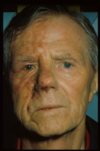The Acute Red Eye Flashcards
how do contact lenses affect infectious presentation
delay it - act as a bandage to the eye
blepharitis
- lid inflammation
- the eyes have burning, itchy red margins with scales on the lashes
- gritty eyes
- FB sensation
- mild discharge
- dry eyes

which part of the lid is redder in anterior blepharitis
lid margin redder than deeper part of lid
anterior blepharitis: seborrheic dermatitis
squamous
there are red lid margins, greasy sclaes on lashes, which are stuck together
dandruff
there is no ulceration

anterior blepharitis: staphylococcal
ulcerative - infection involving lash follicle
there is a red lid margin
eyelashes are distorted, some trichiasis
there is matted hard crusts around lashes, with scarring and hypertrophy if long standing. removal of crusts leaves small ulcers which bleed/ooze
styes are seen

trichiasis
in growing of eye lashes

stye
red/tender lump caused by an infection of an oil gland of the eyelid - hordeolum

which type of stye is seen in staphylococcal anterior blepharitis
hordeolum externum - abscess/infection in the glands of Moll in the lash follicle
points outwards and may cause much inflammation

what effect does trichiasis have on the cornea
irritates it - corneal staining and marginal ulcers
posterior blepharitis
due to meibomian gland dysfunction
secretions of the gland thicken and block the gland, there is scarring and the glands fill up with secretion
there is insipissated (dried) secretion at the gland openings

describe the appearance of posterior blepharitis
redness in the deeper part of the lid, margins appear quite normal

what type of stye is seen in posterior blepharitis
hordoleum internum - abscess of tarsal glands, point inwards opening onto conjunctiva and cause less of a local reaction but leave residual swelling called a chalazion/Meibomian cyst when they subside

pic: chalazion
hordeolum internum and externum

what is blepharitis a common cause of
secondary infections eg conjunctivitis, keratitis, episcleritis
what is the most common manifestation of ocular rosacea (acne rosacea)
anterior and posterior blepharitis
treatment of blepharitis
lid hygiene is essential, crusts must be cleaned off lashes
supplementary tear drops
oral doxycycline for 2-3 months
difficult to eradicate
general symptoms of conjunctivitis
red and inflamed conjunctiva
eyes itch burn and lacrimate
pain on eye movement
FB sensation - gritty eye
may be photophobia
often bilateral with eyelids sticking together
what is unaffected in conjunctivitis
vision (acuity), pupillary responses and corneal lustre
chemosis
odema of conjunctiva
non specific sign of eye irritation

allergic conjunctivitis
stringy discharge
itch
papillae present
what is allergic conjunctivitis treated with
anti-histamine drops
3 most common causes of bacterial conjunctivits in neonates
- Staph. aureus
- Neisseria gonorrhoea
- Chlamydia trachomatis
3 most common causes of bacterial conjunctivitis
- Staph. aureus
- Strep, pneumoniae
- H. influenzae (especially in children)
bacterial conjunctivitis
red sticky eye
purulent discharge
papillae - red, small and circular


























